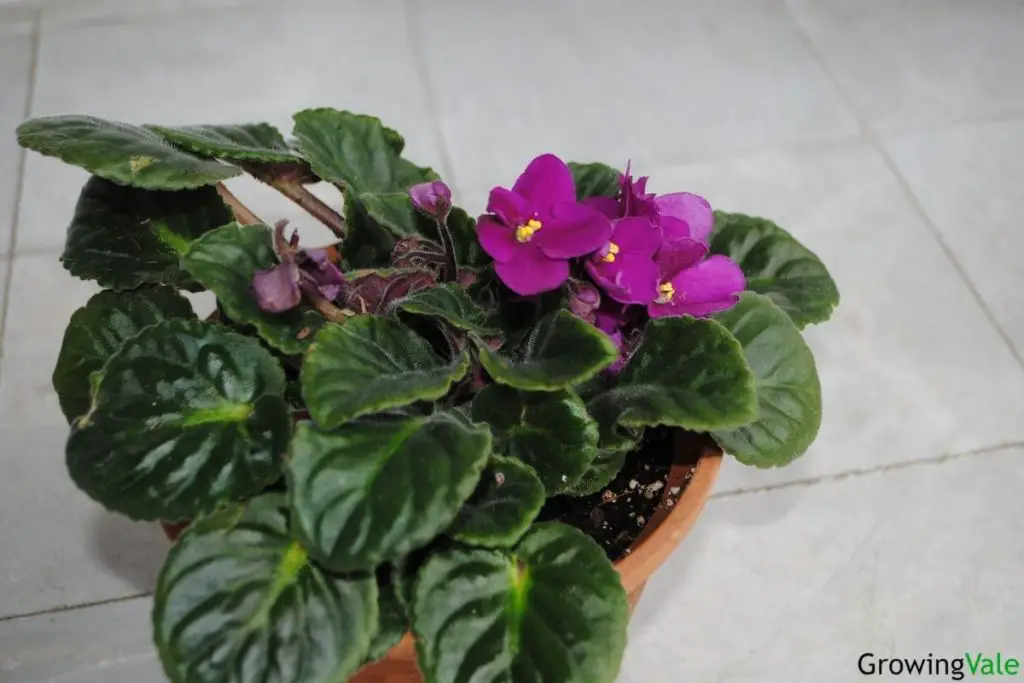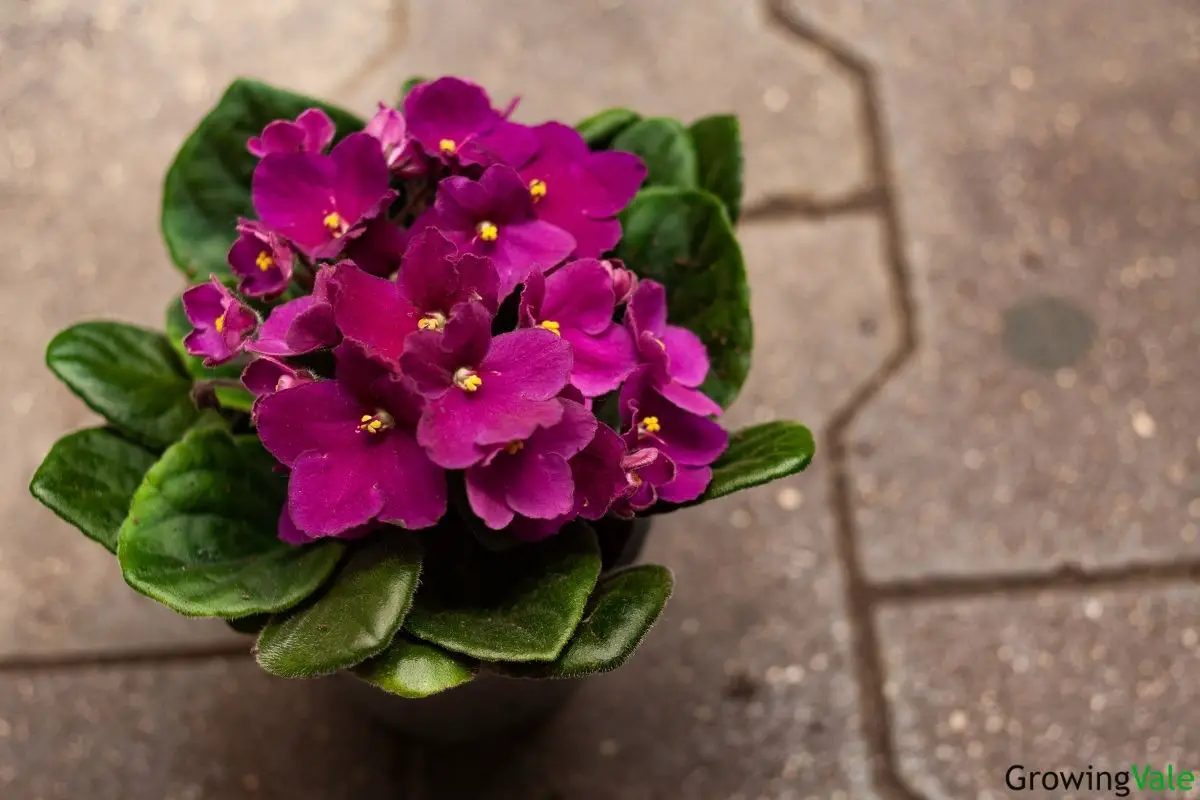African violets have some characteristics that provide natural protective function, and the emergence of new cultivars has reflected significant progress in inducing pest resistance within the species. Still, this herbaceous ornamental can fall vulnerable to certain pests and diseases.
Are your African violet leaves turning yellow or brown? How do you prevent or fix the problems? Let’s find out!
Innate Protective Mechanisms
The African violet leaf surfaces have round, glandular trichomes that can ward off pests while reducing evaporation of moisture. These “hairy” structures make it difficult for insects and other animals to chew on the plant. In addition, pigments expressed in their blossoms are anthocyanins that potentially deter herbivores aside from being a natural sunscreen against harmful UV rays.

Diseases in African Violets
Diseases in saintpaulias may arise despite ample maintenance, hence, the knowledge of early diagnosis and symptoms, as well as specific prevention and treatment, is very useful.
Crown Rot and Root Rot
Fungi species thrive when an African violet is overwatered, poor-draining, and planted too deep. Roots look dark brown, while the crown is wilted. If the African violet leaves fall off, likely it is Rhizoctonia sp., while Pythium ultimum makes the leaves turn yellow. Phytophthora sp. causes the crowns and roots to look water-soaked, but the leaves stay firmly attached even if the crown collapses.
Botrytis Blight
Botrytis cinerea is the grey mold that appears in very humid conditions, producing water-soaked lesions in the petioles, and spreading to the abaxial region of the leaves. Flowers do not fully develop, and eventually, the infected parts turn dark brown to gray, with some moldy, fuzzy outgrowths over discolored surfaces. Plants are not good for propagating materials.
Powdery Mildew
The spores of Oidium sp. are difficult to avoid, as they are the most common especially in humid places. They appear as light gray powders on leaf and floral surfaces, forming whitish spots and floral deformities and damages. Lysol or baking soda solution can be first aid, but if there is no improvement for two days, use stronger fungicides. If left untreated, AVs likely dry out and die.
Bacterial Rot
Petioles, crowns, and leaves infected by Erwinia chrysanthemi experience macerations and holes from being extremely water-soaked, with dark, rotting areas having a greasy surface. The foliage would also appear paler than healthy plants. At early stages, infested parts can just be removed, but very ill individuals must not be propagated.
Prevention and Treatment of Fungal and Bacterial Diseases
When handling saintpaulias, especially in repotting, disinfection of hands, tools, and pots must be observed. Overwatering and overfertilizing, and extreme temperature changes also promote bacterial and fungal growth. Infected plants must be isolated from healthy ones. A self-watering pot is advised for indoor AVs, which facilitates water only as needed. Affected plants must not be used for propagation.
When removing infected parts, be careful not to mist, wet, or agitate the outgrowths to ensure that spores do not spread. Prune in a well-ventilated room to mitigate the high humidity. Fungicide treatment for fungal pathogens may also leave some spores behind, so cleaning of treatment and storage areas before and after the application is done to avoid this.
Pests Infesting African Violets
Cyclamen Mites
Among all the mites that feast on African violets, cyclamen mites (Steneotarsonemus pallidus) are the most dangerous. They are microscopic and yet produce extensive damage. They prefer thriving on new growths and leaf folds to evade sunlight while they suck on these plant parts. Upon feeding, they introduce a toxic substance to the plant that disrupts its growth patterns.
Symptoms include leaf curling upwards, stunted growth, with new leaves in the crowns having more surface hair than usual. Some leaf buds fail to open. Spraying with insecticidal soap can control the mites, while damaged parts are cut off.
Mealybugs
Both occurring in the soil and leaves, these leaf bugs have a cottony appearance and stick to the leaf bases to suck on its juices, while the soil-thriving types look like rice grains or perlite and suck on the root extracts. Wiping with alcohol-drenched cotton balls or swabs will make the bugs on foliage fall off, but for the root areas, insecticides are applied.
Thrips
Are very common, and most especially appear on the blossoms, looking like thread fragments headed towards the anthers since they aim for the pollen. A sign of their presence is seeing some pollen split and scattered on the petals. Their infestation is difficult to treat, and mild insecticides for home use do not eliminate them, although regular treatment helps.
Other Problems
Ring Spots
When the plant comes in contact with cold water, it may produce yellow or white rings on its petioles. It is better to mist only when needed (such as when the leaves and flowers collect dust), and make sure that the water used is not colder than the leaf temperature when touched.
Petiole Rot
Rusty marks on the regions bordering the petiole and the pot can indicate accumulated fertilizer salts or other minerals from the water. This can mean overfertilizing or that the water source should be changed. Clean out the pot and possibly replace the soil, if not leach out the salts by flushing with running water. This is not technically a disease until root rot sets in due to the salts.
Specific fungicides and insecticides may target corresponding pathogens accordingly, although mild insecticidal soaps, neem oil, pyrethrins, and other antifungal and home remedies can also be employed, aside from maintaining cleanliness during the handling of these precious gems.
FAQs
What does an overwatered African violet look like?
An overwatered African violet will look very soggy, even if the leaves do not fall off just yet. This is a favorable environment for fungal growth, resulting in the major diseases of the plant. Even if symptoms are not yet showing, earlier measures include adding drainage holes and improving air circulation, or relocating the pot to less humid areas.
What to do if your African violet is dying?
First, observe its symptoms. If a saintpaulia is just undernourished or overfertilized, it will show improved health within two to three weeks of treatment, by the procedure of stopping the fertilizer, and then continuing it if the symptoms get worse. If after determining that the African violet plant is not affected by the change in fertilization habits, or if rotting occurs, it must be isolated from the healthy pots and treated with fungicide or insecticide.
Some dangerous microbes, especially fungi, are not killed off by these chemicals and will entail discarding the entire plant after dying. If after removal of the infected regions, the symptom does not improve, it is best to not use even the healthier parts for propagation. An improved plant, however, can be repotted and observed further if acceptable as new planting material.
*References
Reference list:
Doubrava, N. Scott, J. M., Blake, J. H., & Gorsuch, C. S. 2018 Aug 8. African Violet Diseases and Insect Pests (Factsheet). Home and Garden Information Center – Clemenson Cooperative Extension website. https://site.caes.uga.edu/sehp/files/2020/04/Clemson-African-Violet-Diseases-and-Insect-Pests.pdf
Gardner, S. 2009 Sep-Oct. Recognizing Early Signs of Some Pests and Diseases. African Violets Magazine 62(5): 36-37.
Johansson, D. R. 1978 July. Saintpaulias in their natural environment with notes on their present status in Tanzania and Kenya. Biological Conservation 14(1): 46-62. https://doi.org/10.1016/0006-3207(78)90005-8
McCaleb, W. H. 2011. African Violets. Virginia Polytechnic Institute and State University. https://vtechworks.lib.vt.edu/bitstream/handle/10919/48328/VCE_African_Violets.pdf?sequence=1&isAllowed=y
Snetsinger, R. 1966 Oct 1. Biology and Control of a Root-feeding Mealybug on Saintpaulia, Journal of Economic Entomology, 59(5): Pages 1077–1078, https://doi.org/10.1093/jee/59.5.1077
”Close”

